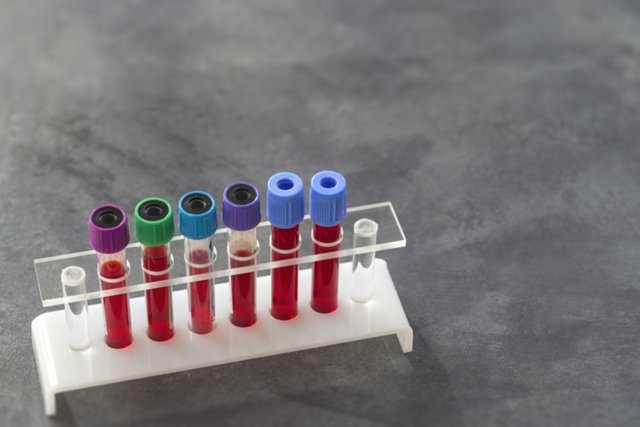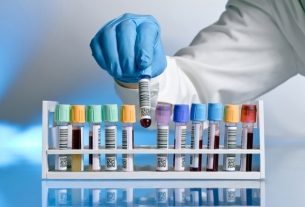Activated partial thromboplastin, or APTT, is the test that evaluates blood clotting. This test checks how long it takes for clot formation to occur after exposure of the collected blood to reagents and calcium chloride.
This test is mainly indicated to monitor the use of heparin and the presence or absence of clotting factors, being useful for evaluating secondary hemostasis and, thus, diagnosing changes such as hemophilia, von Willebrand disease and thrombophilia, for example. Understand what hemostasis is and how it happens.
The APTT is part of the coagulogram, and it is important that its result is evaluated together with the results of other tests recommended by the doctor so that the diagnosis is more accurate and, thus, it is possible to initiate the best treatment, if necessary.

What is the exam for?
The activated partial thromboplastin test is used to:
- Assess blood clotting;
- Check the presence, absence and deficiency of intrinsic and common pathway clotting factors;
- Monitor heparin therapy.
The APTT exam is normally indicated together with other coagulogram exams, such as bleeding time (TS), prothrombin time (PT), thrombin time (TT) and number of platelets. Learn more about the coagulogram.
If you wish, make an appointment with your nearest doctor to assess the need for the APTT exam:
Taking care of your health has never been easier!
How is APTT done?
The APTT test is carried out by collecting a blood sample, which is sent to the laboratory for analysis. It is important to follow the laboratory’s recommendation on fasting, as it may be recommended in some cases to fast for 4 hours. Furthermore, it is important to inform the use of medications, especially anticoagulants, and avoid drinking alcoholic beverages the day before the exam.
In the laboratory, the collected blood is exposed to a reagent that contains substances that act as platelet substitutes. Then, calcium chloride is added to check how long it takes for the clot to form.
Reference value
The reference value may vary according to the laboratory and reagent used, however, in general, the exam is considered normal when APTT is between 21 and 32 seconds. When APTT is greater than 32 seconds, it is indicated on the exam that the APTT is enlarged.
It is important that the result of the APTT test is interpreted by the doctor together with the results of other coagulogram and blood count tests, and it is also important to observe the reference value indicated by the laboratory.
What does the result mean
Depending on the value of the APTT exam, the result may be:
1. Elongated TTPA
Extended APTT is when the test result is higher than the reference value, indicating that the blood takes longer than normal to clot. The main causes of increased APTT are:
- Use of heparin;
- Liver diseases, as clotting factors are produced in the liver;
- Hemophilia A, in which there is a deficiency of coagulation factor VIII:
- Hemophilia B, in which there is a deficiency of coagulation factor IX;
- von Willebrand disease;
- Vitamin K deficiency;
- Disseminated intravascular coagulation (DIC).
Furthermore, APTT may be enlarged in people who use medications, such as acetylsalicylic acid and antibiotics, such as metronidazole, aztreonam and ofloxacin.
2. Shortened APTT
Shortened APTT is when the test result is lower than the reference value, so that clotting occurs faster than normal, resulting in a greater risk of clot formation. This change is more common in people who have more advanced cancer or have thrombophilia, which is a change in clotting factors that directly interferes with clotting and increases the risk of complications. Learn more about thrombophilia and possible complications.
Furthermore, decreased APTT may be a consequence of the use of antihistamines, digitalis and contraceptive medications.
Bibliography
- LABTEST. Technical guide – Coagulation. 2016. Available at: <https://labtest.com.br/wp-content/uploads/2016/09/Guia_Tecnico_Coagulacao.pdf>. Accessed on June 23, 2023
- UNIVERSITY OF ROCHESTER MEDICAL CENTER. Activated Partial Thromboplastin Clotting Time. Available at: <https://www.urmc.rochester.edu/encyclopedia/content.aspx?contenttypeid=167&contentid=aptt>. Accessed on June 23, 2023
- ROUNTREE, KAITLYN M.; YAKER, ZACHARY; LOPEZ, PETER P. Partial Thromboplastin Time. 2022. Available at: <https://www.ncbi.nlm.nih.gov/books/NBK507772/>. Accessed on June 23, 2023
- VASCONCELOS, Rosângela B. Coagulogram – Hemostasis: coagulation mechanisms and laboratory evaluation. 2022. Disponível em: <https://dspace.uniceplac.edu.br/bitstream/123456789/1204/1/Coagulograma%20-%20hemostasia%20-%20mecanismos%20de%20coagula%C3%A7%C3%A3o%20e%20avalia%C3%A7%C3%A3o%20laboratorial.pdf>.
- BIOCLIN. TTPA Bioclin – Instructions for use. 2020. Available at: <https://quibasa.bioclin.com.br/anexos/INSTRUCOES_TTPA_BIOCLIN.pdf>. Accessed on June 23, 2023

Sign up for our newsletter and stay up to date with exclusive news
that can transform your routine!
Warning: Undefined array key "title" in /home/storelat/public_html/wp-content/plugins/link-whisper-premium/templates/frontend/related-posts.php on line 12
Warning: Undefined array key "title_tag" in /home/storelat/public_html/wp-content/plugins/link-whisper-premium/templates/frontend/related-posts.php on line 13



